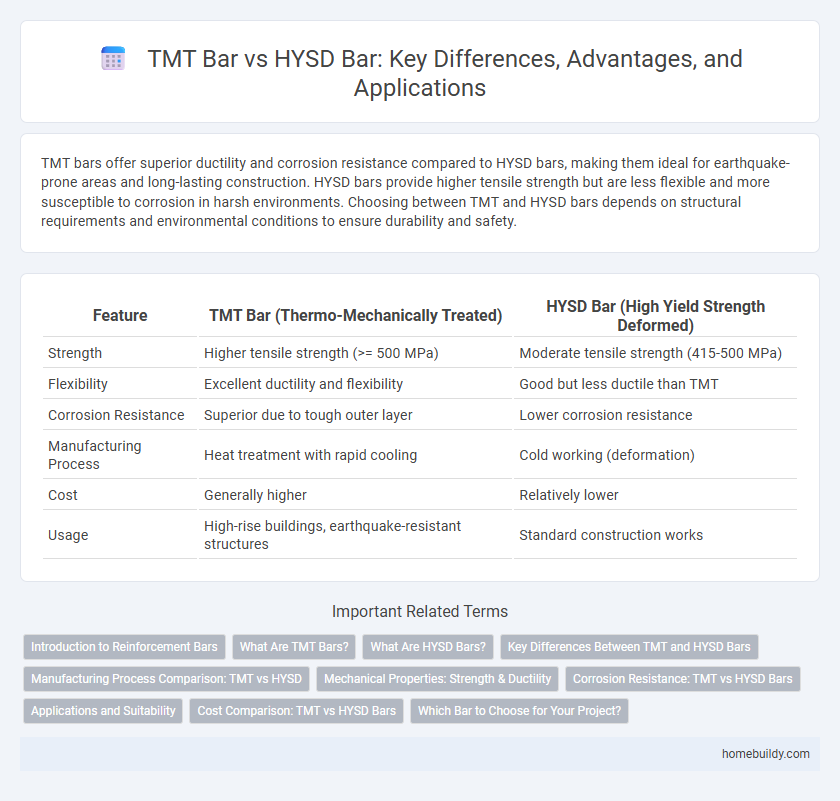TMT bars offer superior ductility and corrosion resistance compared to HYSD bars, making them ideal for earthquake-prone areas and long-lasting construction. HYSD bars provide higher tensile strength but are less flexible and more susceptible to corrosion in harsh environments. Choosing between TMT and HYSD bars depends on structural requirements and environmental conditions to ensure durability and safety.
Table of Comparison
| Feature | TMT Bar (Thermo-Mechanically Treated) | HYSD Bar (High Yield Strength Deformed) |
|---|---|---|
| Strength | Higher tensile strength (>= 500 MPa) | Moderate tensile strength (415-500 MPa) |
| Flexibility | Excellent ductility and flexibility | Good but less ductile than TMT |
| Corrosion Resistance | Superior due to tough outer layer | Lower corrosion resistance |
| Manufacturing Process | Heat treatment with rapid cooling | Cold working (deformation) |
| Cost | Generally higher | Relatively lower |
| Usage | High-rise buildings, earthquake-resistant structures | Standard construction works |
Introduction to Reinforcement Bars
TMT bars (Thermo Mechanically Treated bars) and HYSD bars (High Yield Strength Deformed bars) are both essential types of reinforcement bars used in construction for enhancing the strength of concrete structures. TMT bars offer superior ductility, high tensile strength, and corrosion resistance due to their unique thermo-mechanical treatment process, making them ideal for earthquake-resistant constructions. HYSD bars provide higher yield strength and improved bonding with concrete but generally lack the corrosion resistance and ductility of TMT bars, influencing the choice of reinforcement based on the structural requirements.
What Are TMT Bars?
TMT bars, or Thermo Mechanically Treated bars, are high-strength reinforcement bars known for their superior ductility and corrosion resistance, making them ideal for seismic and structural applications. They undergo a specialized heat treatment process that produces a tough outer surface and a softer core, enhancing their tensile strength compared to HYSD (High Yield Strength Deformed) bars. TMT bars offer improved welding properties and better bonding with concrete, ensuring enhanced durability and safety in construction projects.
What Are HYSD Bars?
HYSD bars, or High Yield Strength Deformed bars, are reinforcing steel bars characterized by their high tensile strength and enhanced resistance to corrosion, commonly used in concrete structures to improve durability and load-bearing capacity. Unlike TMT (Thermo Mechanically Treated) bars, HYSD bars achieve strength through controlled chemical composition and heat treatment processes that produce ribbed patterns for better bonding with concrete. HYSD bars typically offer superior mechanical properties and ductility, making them suitable for seismic and heavy-load applications in construction projects.
Key Differences Between TMT and HYSD Bars
TMT bars feature a tough outer surface and a softer inner core, offering high tensile strength and excellent ductility, while HYSD bars possess uniform strength throughout but typically have lower ductility. TMT bars are produced through a thermo-mechanical treatment process that enhances corrosion resistance and weldability, whereas HYSD bars are hot-rolled bars with controlled carbon content for strength. The superior bonding strength of TMT bars with concrete and their improved seismic resistance make them more suitable for earthquake-prone regions compared to HYSD bars.
Manufacturing Process Comparison: TMT vs HYSD
TMT bars undergo a thermo-mechanical treatment involving rapid cooling and controlled heat treatment, resulting in a tough outer layer and ductile core with superior tensile strength and corrosion resistance. HYSD bars are manufactured through hot rolling followed by controlled cooling, achieving high yield strength but less uniform microstructure compared to TMT bars. The advanced cooling process in TMT bars enhances seismic resistance and longevity, making them preferable for critical construction applications.
Mechanical Properties: Strength & Ductility
TMT bars exhibit superior mechanical properties compared to HYSD bars, offering higher tensile strength and enhanced ductility that improve structural safety under seismic loads. The controlled manufacturing process of TMT bars produces a tough outer surface with a softer core, optimizing strength and flexibility simultaneously. In contrast, HYSD bars generally have lower yield strength and reduced ductility, limiting their effectiveness in dynamic load applications.
Corrosion Resistance: TMT vs HYSD Bars
TMT bars exhibit superior corrosion resistance compared to HYSD bars due to their thermo-mechanical treatment process, which creates a tough outer surface and ductile inner core, enhancing durability in harsh environments. HYSD bars, although strong, have a relatively higher susceptibility to corrosion due to their uniform carbon content and lack of protective surface layer. Therefore, TMT bars are preferred for reinforced concrete structures exposed to moisture and aggressive conditions, ensuring longer service life and reduced maintenance costs.
Applications and Suitability
TMT bars, with their superior thermal treatment and ductility, are ideal for high-rise buildings and seismic zones where enhanced strength and flexibility are critical, while HYSD bars are commonly used in standard construction projects requiring moderate tensile strength and corrosion resistance. TMT bars exhibit better weldability and bond strength, making them suitable for infrastructure like bridges and industrial buildings that demand long-term durability. HYSD bars, often preferred for residential and light commercial structures, offer cost-effectiveness but fall short in applications requiring high corrosion resistance and flexibility.
Cost Comparison: TMT vs HYSD Bars
TMT bars generally offer better cost efficiency compared to HYSD bars due to their lower production expenses and enhanced durability, reducing long-term maintenance costs. HYSD bars, while cheaper initially, may require more frequent replacement or repair because of comparatively lower corrosion resistance. The total cost of ownership favors TMT bars given their superior strength, ductility, and lifespan in construction applications.
Which Bar to Choose for Your Project?
TMT bars offer superior strength, ductility, and corrosion resistance compared to HYSD bars, making them the preferred choice for seismic-resistant and long-lasting constructions. HYSD bars, with their ribbed surface and moderate tensile strength, are suitable for low to medium load-bearing structures where budget constraints exist. For projects requiring enhanced durability and structural integrity, TMT bars provide better performance and longevity, ensuring safer and more reliable construction outcomes.
TMT bar vs HYSD bar Infographic

 homebuildy.com
homebuildy.com